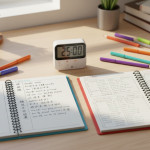Why Clock Management Matters (Even Without Your Phone)
Walk into an AP exam and time becomes your most reliable teammate—if you know how to work with it. Many students rely on phones or smartwatches for timers during practice, but on test day you won’t have those comforts. The good news: clocks exist in the room, and there are smarter, calmer ways to manage time without a personal device. This article gives you practical, human-tested strategies to pace every section, handle surprises, and leave the test center feeling like you owned the time.
The mindset first: Time is information, not the enemy
Think of time like data on a test dashboard. It tells you where you are and what you should do next. When you panic, you lose access to that data. When you plan, you convert clock ticks into decisions—when to push, when to skip, when to review. Your goal is to make the clock a tool that nudges choices rather than a threat that triggers stress.

Before Test Day: Build Device-Free Timing Habits
Practice under the same conditions you’ll face on exam day. That means no phone, no smartwatch, no personal timer. The familiarity breeds calm; the muscle memory trains your internal pacing. Below are the most practical exercises you can do in the two weeks leading up to any AP exam.
Practice drills to internalize pace
- Timed mini-sections: Break a practice exam section into chunks and time them with a wall clock or kitchen timer placed out of arm’s reach. Practice finishing each chunk with the same margin you want on exam day.
- Segment pacing: Learn to read the clock at consistent intervals—every 10 or 15 minutes—and convert the remaining time into question goals.
- Silent checkpoints: During a full practice run, glance only twice per section at the room clock: once at the start, once at the midpoint (or at a predetermined checkpoint). Build your confidence in estimating remaining time between checks.
Simulate the environment
Use a library or classroom with a visible wall clock. Silence or store away devices completely during practice—and practice filling answer sheets (bubbles) and transfer steps without digital aids. This trains the procedural fluency you’ll need on test day so timing feels natural, not rushed.
During the Exam: Practical Tactics for Every Section
Each AP exam has its own rhythm: multiple-choice speed, free-response composition, and lab or problem-solving sections. The table below provides a compact pacing plan you can adapt for the most common structures. Use it as a baseline and customize for your comfort level.
Sample Pacing Table
| Section | Total Time | Strategy | Target Pacing |
|---|---|---|---|
| Multiple Choice (30 questions) | 60 minutes | Quick read, mark hard ones, answer easy first, return to marked. | 2 minutes per question; 10–15 min buffer for review. |
| Short Answer / Free Response (4 prompts) | 60 minutes | Skim prompts, plan outlines, write efficiently; leave last 5–10 for review. | Allocate time per prompt by weight (e.g., 10–20 min each) with a 5–10 min buffer. |
| Long Free Response / Essay | 50–80 minutes | Spend 5–10 planning, 30–60 writing, last 5–10 reviewing and polishing. | Plan 10% of time, write 80%, review 10%. |
Use this table as a starting point. The key is to translate total time into small, actionable checkpoints you can check against the room clock.
Step-by-step timing routine (no device required)
- Immediately note the clock time when you receive the test materials. Write it at the top of your scratch paper (e.g., “Starts: 9:07 AM”).
- Calculate the end time for the section in whole minutes (e.g., 60 minutes → 10:07 AM). Writing the end time reduces mental arithmetic during the exam.
- Decide your first checkpoint (for a 60-minute section, checkpoints at 30, 15, and 5 minutes work well). Note those times on scratch paper (e.g., “Checkpoint1: 9:37 AM”).
- Work the section with your plan. At each checkpoint glance up at the clock and compare progress to goals—questions answered, passage tackled, or pages drafted.
Simple Mental Math Tricks for Fast Estimation
You don’t need a calculator to estimate pace. Use these mental shortcuts to convert minutes into question targets or writing goals.
Quick conversions
- Roughly divide longer sections into thirds: if you have 60 minutes, think 20/20/20 for rough milestones.
- If you have a 30-question section in 60 minutes, subtract 1 minute per question and keep 10–15 extra minutes for review—so aim for 45–50 questions answered in the first pass then use buffer time for the rest (this is more applicable to larger MC sets).
- Use round minutes for easier math. If the clock shows 9:07 and the end-time is 10:05, think “less than an hour” and set the checkpoint for 9:37 (30 minutes), not for precise seconds.
When to Skip and When to Stay
Deciding whether to skip a question is time-management gold. The test rewards flow: keep moving when a problem will cost disproportionate time, and return later with fresh eyes.
The skip rule of thumb
- If a multiple-choice question looks like it will take more than twice the average time per question, flag it and move on.
- For free-response parts, if you’re stuck beyond your allotted planning window (for example, more than 10 minutes on a long essay planning step), jot a quick thesis or approach and move to the next task—come back to polish if time allows.
- Count flagged questions and estimate time needed to return. If the time to return exceeds the remaining buffer, prioritize the highest-scoring or highest-confidence flagged items.
Bubble-Filling and Transfer Time: A Small But Critical Edge
Don’t forget the mechanical tasks: bubbling answers, transferring responses, labeling graphs. These small steps can steal minutes if you’re hurried.
Practical tips
- If answers are on a separate sheet, leave time at the end specifically for transfer. Write the transfer end-time into your checkpoint list.
- Bubble in consistent clusters—don’t hop around randomly. This reduces mistakes and wasted time checking alignment.
- Allow a 5–8 minute final sweep to ensure bubbles and free responses are in the right places.
Using Proctor Announcements and Room Clocks as Allies
Proctors will call out time cues. Know how to fold these into your plan so they reinforce rather than disorient you.
How to listen and act
- When a proctor says “30 minutes remaining,” check your checkpoints and adjust pace. If you’re behind, prioritize high-yield questions for the remaining time.
- If the proctor announces an exact end time, mentally align that with your written end time and update checkpoints if necessary.
- Use the proctor’s statements as confirmation—don’t rely on them exclusively. Always have your own clock-based plan written down.

Handling Unexpected Delays or Extra Time
Sometimes the testing environment changes: a delay starts the section late, or you get a few extra minutes. Don’t be thrown off—treat any change as modified data and update your plan immediately.
Adjusting quickly
- If your start time is later than expected, rewrite your end time and recompute checkpoints—don’t try to guess or rush based on memory.
- If you receive extra minutes, use them strategically: finish flagged items first, then do a quick quality pass on essays or calculations.
Quick Checklists for Test Day
One simple sheet can be the difference between calm and chaos. Prepare a tiny “Timing Cheat Sheet” to keep in your mind and on scratch paper when permitted.
Timing Cheat Sheet (What to write first on scratch paper)
- Section name and official time window (e.g., “MC: 9:10–10:10”).
- Exact end time (e.g., “End: 10:10 AM”).
- Checkpoints—midpoint and two smaller marks (e.g., “Mid: 9:40; 15: 9:55”).
- Number of questions to finish before first checkpoint (e.g., “Q by Mid: 20”).
- A short note on where to start (e.g., “Read passage A quickly; do 1–4 then 7–10”).
Practice Plan: Two Weeks to Mastery
Here’s a compact, device-free practice schedule you can follow in the two weeks before your AP exam. This focuses on building habit over cramming.
Week-by-week guide
- Days 1–3: Time mini-sections under a wall clock, practice checkpoints, and write down start/end times on scratch paper.
- Days 4–7: Full sections in test-like conditions (no device), focusing on bubble transfer and time checks every 10–15 minutes.
- Days 8–11: Full practice tests under the clock. Simulate proctor announcements by setting public clocks or using a classroom setting.
- Days 12–14: Light practice focused on weak areas, review pacing notes, and mental rehearsal of the timing routine before sleep.
How Personalized Tutoring Can Fast-Track Your Timing Skills
Generic tips are useful, but timing is personal: how you write an essay or solve a problem influences pacing choices. That’s where targeted, 1-on-1 coaching accelerates progress. Sparkl’s personalized tutoring can help you craft a pacing plan tailored to your reading speed, writing style, and section strengths—offering expert tutors, tailored study plans, and AI-driven insights to refine your checkpoints and simulate test conditions you’ll face without a device.
What to expect from targeted sessions
- Diagnostic sessions that measure your true per-question and per-prompt speed.
- Pacing plans based on your strengths and test structure, not a one-size-fits-all formula.
- Timed practice under realistic conditions with feedback on when you hesitated and how to shave off precious minutes.
Common Timing Pitfalls and How to Avoid Them
Students repeat a handful of timing mistakes that are easy to fix once you know them. Awareness plus a short corrective strategy is enough to prevent most of these on test day.
Pitfalls and fixes
- Over-checking the clock: If you check every few minutes, your head gets fragmented. Fix: choose 2–4 checkpoints per section and stick to them.
- Failing to re-evaluate flagged items: Marking a question but never returning wastes potential points. Fix: allocate a return window and prioritize flagged items by relative difficulty.
- Not writing down the start/end times: Relying on mental arithmetic invites error. Fix: write times on scratch paper immediately.
Final Moments Before You Hand In Your Test
As you approach the final checkpoint, shift your mindset from hunting for perfect answers to maximizing points. Use the last 5–10 minutes strategically.
Last-minute priorities
- Fill in any unanswered bubbles first—one likely correct answer is better than none.
- On essays, ensure you have a clear thesis and at least one supporting example; polish only if time remains.
- Check that your answer sheets are properly labeled and that you followed instructions for free-response formatting.
Wrap-Up: Timing Is a Skill You Can Train
Clock management without a personal device is less about raw speed and more about predictable, calm decision-making. The strategies above—written checkpoints, mental math, deliberate skipping, and device-free practice—turn time from an adversary into your ally. A little structure in your approach will buy you clarity when it matters most.
If you want to refine these techniques for your specific AP subject, consider working with an expert who can observe your test-taking rhythm and tailor a strategy. Sparkl’s personalized tutoring is designed to do just that: build study plans that fit you, provide targeted 1-on-1 guidance, and use AI-driven insights to track and improve your pace so that when test day arrives, you’re not guessing—you’re executing.
One last piece of advice
Practice calmly. The more you simulate device-free conditions, the more natural and automatic your timing routine will become. On test day, slow your breathing, write your start and end time, and trust the plan you practiced. Time will feel like a partner—because you taught it to be.



















No Comments
Leave a comment Cancel